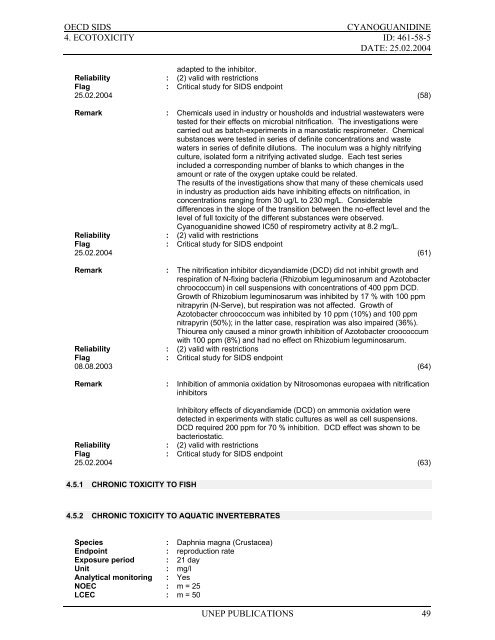Cyanoguanidine CAS N°: 461-58-5
Cyanoguanidine CAS N°: 461-58-5
Cyanoguanidine CAS N°: 461-58-5
You also want an ePaper? Increase the reach of your titles
YUMPU automatically turns print PDFs into web optimized ePapers that Google loves.
OECD SIDS<br />
CYANOGUANIDINE<br />
4. ECOTOXICITY ID: <strong>461</strong>-<strong>58</strong>-5<br />
DATE: 25.02.2004<br />
adapted to the inhibitor.<br />
Reliability : (2) valid with restrictions<br />
Flag : Critical study for SIDS endpoint<br />
25.02.2004 (<strong>58</strong>)<br />
Remark : Chemicals used in industry or housholds and industrial wastewaters were<br />
tested for their effects on microbial nitrification. The investigations were<br />
carried out as batch-experiments in a manostatic respirometer. Chemical<br />
substances were tested in series of definite concentrations and waste<br />
waters in series of definite dilutions. The inoculum was a highly nitrifying<br />
culture, isolated form a nitrifying activated sludge. Each test series<br />
included a corresponding number of blanks to which changes in the<br />
amount or rate of the oxygen uptake could be related.<br />
The results of the investigations show that many of these chemicals used<br />
in industry as production aids have inhibiting effects on nitrification, in<br />
concentrations ranging from 30 ug/L to 230 mg/L. Considerable<br />
differences in the slope of the transition between the no-effect level and the<br />
level of full toxicity of the different substances were observed.<br />
<strong>Cyanoguanidine</strong> showed IC50 of respirometry activity at 8.2 mg/L.<br />
Reliability : (2) valid with restrictions<br />
Flag : Critical study for SIDS endpoint<br />
25.02.2004 (61)<br />
Remark : The nitrification inhibitor dicyandiamide (DCD) did not inhibit growth and<br />
respiration of N-fixing bacteria (Rhizobium leguminosarum and Azotobacter<br />
chroococcum) in cell suspensions with concentrations of 400 ppm DCD.<br />
Growth of Rhizobium leguminosarum was inhibited by 17 % with 100 ppm<br />
nitrapyrin (N-Serve), but respiration was not affected. Growth of<br />
Azotobacter chroococcum was inhibited by 10 ppm (10%) and 100 ppm<br />
nitrapyrin (50%); in the latter case, respiration was also impaired (36%).<br />
Thiourea only caused a minor growth inhibition of Azotobacter croococcum<br />
with 100 ppm (8%) and had no effect on Rhizobium leguminosarum.<br />
Reliability : (2) valid with restrictions<br />
Flag : Critical study for SIDS endpoint<br />
08.08.2003 (64)<br />
Remark : Inhibition of ammonia oxidation by Nitrosomonas europaea with nitrification<br />
inhibitors<br />
Inhibitory effects of dicyandiamide (DCD) on ammonia oxidation were<br />
detected in experiments with static cultures as well as cell suspensions.<br />
DCD required 200 ppm for 70 % inhibition. DCD effect was shown to be<br />
bacteriostatic.<br />
Reliability : (2) valid with restrictions<br />
Flag : Critical study for SIDS endpoint<br />
25.02.2004 (63)<br />
4.5.1 CHRONIC TOXICITY TO FISH<br />
4.5.2 CHRONIC TOXICITY TO AQUATIC INVERTEBRATES<br />
Species : Daphnia magna (Crustacea)<br />
Endpoint : reproduction rate<br />
Exposure period : 21 day<br />
Unit : mg/l<br />
Analytical monitoring : Yes<br />
NOEC : m = 25<br />
LCEC : m = 50<br />
UNEP PUBLICATIONS 49
















